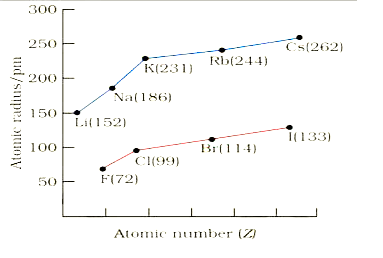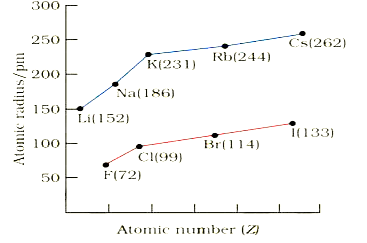A ) Non -metals are generally more electronegatinve
R ) Electronegativity increases as atomic radius decreases . Solution in Telugu
A and R are true R. supports A .
A and R are true , R does not support A
A' is true but 'R' is wrong
A' is wrong but 'R' is true
The correct Answer is:A
Step by step video, text & image solution for A ) Non -metals are generally more electronegatinve R ) Electronegativity increases as atomic radius decreases . by Chemistry experts to help you in doubts & scoring excellent marks in Class 10 exams.
Updated on:21/07/2023Topper's Solved these Questions
- CLASSIFICATION OF ELEMENTS -THE PERIODIC TABLE BOOK - VGS PUBLICATION-BRILLIANTCHAPTER - CLASSIFICATION OF ELEMENTS -THE PERIODIC TABLE EXERCISE - CREATIVE QUESTIONS FOR NEW MODEL EXAMINATION (SECTION -II)
8 Videos
- CLASSIFICATION OF ELEMENTS -THE PERIODIC TABLE BOOK - VGS PUBLICATION-BRILLIANTCHAPTER - CLASSIFICATION OF ELEMENTS -THE PERIODIC TABLE EXERCISE - CREATIVE QUESTIONS FOR NEW MODEL EXAMINATION (SECTION -II) (CONCEPUAL UNDERSTANDING )
43 Videos
- CLASSIFICATION OF ELEMENTS -THE PERIODIC TABLE BOOK - VGS PUBLICATION-BRILLIANTCHAPTER - CLASSIFICATION OF ELEMENTS -THE PERIODIC TABLE EXERCISE - QUESTIONS GIVEN IN THE LESSON (2 MARK QUESTIONS)
2 Videos
- CHEMICAL REACTIONS AND EQUATIONSBOOK - VGS PUBLICATION-BRILLIANTCHAPTER - CHEMICAL REACTIONS AND EQUATIONSEXERCISE - OBJECTIVE TYPE QUESTIONS
80 Videos
- CLASSIFICATION OF ELEMENTS-THE PERIODIC TABLESBOOK - VGS PUBLICATION-BRILLIANTCHAPTER - CLASSIFICATION OF ELEMENTS-THE PERIODIC TABLESEXERCISE - EXERCISE
351 Videos
Similar Questions
Which atom is bigger in size , Ne or Ar ? Why ?
View SolutionDefine ' element ' according ot boyle .
View SolutionWhich one between Na and Na+ would have more size ?
View SolutionWhy moist Cl2 is act on bleaching agent ?
View SolutionWhat are the limitations of Mendeleev’s periodic table ? How could the modern periodic table overcome the limitations of Mendeleev’s table?
View SolutionAtoms of metals have only a few electrons in their valence shells while atoms of non-metals generally have more electrons in their valence shells. Metallic character is closely related to atomic radius and ionization enthalpy. Metallic character increases from top to bottom in a group and decreases from left to right in a period. Metallic character is inversely related to electronegativity. Which of the following groups contains metals, non-metals and metalloids-
View SolutionAtoms of metals have only a few electrons in their valence shells while atoms of non-metals generally have more electrons in their valence shells. Metallic character is closely related to atomic radius and ionization enthalpy. Metallic character increases from top to bottom in a group and decreases from left to right in a period. Metallic character is inversely related to electronegativity. Non-metals belong to -
View SolutionAtoms of metals have only a few electrons in their valence shells while atoms of non-metals generally have more electrons in their valence shells. Metallic character is closely related to atomic radius and ionization enthalpy. Metallic character increases from top to bottom in a group and decreases from left to right in a period. Metallic character is inversely related to electronegativity.
Considering the elements B,C,N and F the correct order of their non-metallic character is
View Solution(A): With increase in temperature the conductivity of metals decreases.
(R): With increase in temperature lattice vibrations increase in metals. 2.4×1024 atoms.
View SolutionMetals have few electrons in their valence shell while non-metals generally have more electrons in their valence shell. Metallic character is closely related to atomic radius and ionisation enthalpy. Metallic character increases from top to bottom in a group and decreases from let to right in a period of periodic table. metallic character is inversely related to electronegativity of element. Q. The electronegativity of the following elements increase in the order:
View SolutionMetal atom : Metallic radius :: Non-metallic element : ________________
View SolutionMetallic Character
The ability of an atom to donate electrons and form positive ion (cation) is known as electropositivity or metallic character. Down the group, metallic character increases due to increase in atomic size and across the period, from left to right electropositivity decreases due to decrease in atomic size.
Non-Metallic Character
The ability of an atom to accept electrons to form a negative ion (anion) is called non-metallic character or electronegativity. The elements having high electro-negativity have a higher tendency to gain electrons and form anion. Down the group, electronegativity decreases due to increase in atomic size and across the period, from left to right electronegativity increases due to decrease in atomic size

Which of the following correctly represents the decreasing order of metallic character of Alkali metals plotted in the graph?
View SolutionMetallic Character The ability of an atom to donate electrons and form positive ion (cation) is known as electropositivity or metallic character. Down the group, metallic character increases due to increase in atomic size and across the period, from left to right electropositivity decreases due to decrease in atomic size. Non-Metallic Character The ability of an atom to accept electrons to form a negative ion (anion) is called non-metallic character or electronegativity. The elements having high electro-negativity have a higher tendency to gain electrons and form anion.Down the group, electronegativity decreases due to increase in atomic size and across the period, from left to right electronegativity increases due to decrease in atomic size Hydrogen is placed along with Alkali metals in the modern periodic table though it shows non-metallic character
View SolutionMetallic Character
The ability of an atom to donate electrons and form positive ion (cation) is known as electropositivity or metallic character. Down the group, metallic character increases due to increase in atomic size and across the period, from left to right electropositivity decreases due to decrease in atomic size.
Non-Metallic Character
The ability of an atom to accept electrons to form a negative ion (anion) is called non-metallic character or electronegativity. The elements having high electro-negativity have a higher tendency to gain electrons and form anion. Down the group, electronegativity decreases due to increase in atomic size and across the period, from left to right electronegativity increases due to decrease in atomic size

Which of the following reason correctly justifies that “Fluorine (72pm) has smaller atomic radius than Lithium (152pm)”?
View Solution(i) In a period, atomic radius decreases and ionization enthalpy increases with the increase in atomic number of elements.
(ii) Electronegativity increases with increase in atomic radius.
(iii) Metallic properly decreases with decrease in electronegativity.
(iv) Atomic radius generally increases with increase in metallic property of elements.
If (T) stands for true and (F) for false statement the which-one from following is. true for above statements.
View Solution
